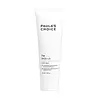What's inside
What's inside
 Key Ingredients
Key Ingredients

 Benefits
Benefits

 Concerns
Concerns

 Ingredients Side-by-side
Ingredients Side-by-side

Water
Skin ConditioningAloe Barbadensis Leaf Juice
Skin ConditioningSesamum Indicum Seed Oil
EmollientCetearyl Alcohol
EmollientCetyl Alcohol
EmollientCeteareth-20
CleansingBambusa Arundinacea Stem Extract
Skin ConditioningJuglans Regia Shell Powder
AbrasiveGlycerin
HumectantSimmondsia Chinensis Seed Oil
EmollientRosa Canina Fruit Oil
EmollientChamomilla Recutita Flower Extract
MaskingArctium Lappa Root Extract
Skin ConditioningTocopherol
AntioxidantCitrus Tangerina Peel Oil
MaskingCitrus Nobilis Peel Oil
MaskingLavandula Angustifolia Oil
MaskingVanillin
MaskingVanilla Planifolia Fruit Extract
Skin ConditioningCitric Acid
BufferingPhenoxyethanol
PreservativeBenzyl Alcohol
PerfumingLinalool
PerfumingLimonene
PerfumingWater, Aloe Barbadensis Leaf Juice, Sesamum Indicum Seed Oil, Cetearyl Alcohol, Cetyl Alcohol, Ceteareth-20, Bambusa Arundinacea Stem Extract, Juglans Regia Shell Powder, Glycerin, Simmondsia Chinensis Seed Oil, Rosa Canina Fruit Oil, Chamomilla Recutita Flower Extract, Arctium Lappa Root Extract, Tocopherol, Citrus Tangerina Peel Oil, Citrus Nobilis Peel Oil, Lavandula Angustifolia Oil, Vanillin, Vanilla Planifolia Fruit Extract, Citric Acid, Phenoxyethanol, Benzyl Alcohol, Linalool, Limonene
Water
Skin ConditioningJojoba Esters
EmollientCaprylic/Capric Triglyceride
MaskingGlycerin
HumectantPEG-20 Methyl Glucose Sesquistearate
EmulsifyingMethyl Glucose Sesquistearate
EmollientTocopheryl Acetate
AntioxidantDecyl Glucoside
CleansingPPG-20 Methyl Glucose Ether
Skin ConditioningGlyceryl Stearate
EmollientStearyl Alcohol
EmollientPolyacrylamide
Sapindus Mukorossi Peel Extract
Skin ConditioningChamomilla Recutita Flower Extract
MaskingCamellia Oleifera Leaf Extract
AstringentXanthan Gum
EmulsifyingC13-14 Isoparaffin
EmollientCaprylyl Glycol
EmollientCitric Acid
BufferingDisodium EDTA
Laureth-7
EmulsifyingPhenoxyethanol
PreservativeEthylhexylglycerin
Skin ConditioningWater, Jojoba Esters, Caprylic/Capric Triglyceride, Glycerin, PEG-20 Methyl Glucose Sesquistearate, Methyl Glucose Sesquistearate, Tocopheryl Acetate, Decyl Glucoside, PPG-20 Methyl Glucose Ether, Glyceryl Stearate, Stearyl Alcohol, Polyacrylamide, Sapindus Mukorossi Peel Extract, Chamomilla Recutita Flower Extract, Camellia Oleifera Leaf Extract, Xanthan Gum, C13-14 Isoparaffin, Caprylyl Glycol, Citric Acid, Disodium EDTA, Laureth-7, Phenoxyethanol, Ethylhexylglycerin
 Reviews
Reviews

Ingredients Explained
These ingredients are found in both products.
Ingredients higher up in an ingredient list are typically present in a larger amount.
Chamomilla Recutita Flower Extract comes from the Chamomile flower.
Chamomile is rich in antioxidants and has anti-inflammatory properties. Several compounds found in chamomile help with soothing, such as bisbolol.
Antioxidant components in chamomile make it an effective ingredient to help slow the signs of aging. Antioxidants help fight free-radical molecules, or molecules that may damage your skin.
Essential oils from chamomile have been found to improve wound healing due to its antimicrobial properties.
Ancient Greeks and Egyptians used Chamomile to treat skin redness and dryness. Chamomile has also been used to help treat stomach issues.
Learn more about Chamomilla Recutita Flower ExtractCitric Acid is an alpha hydroxy acid (AHA) naturally found in citrus fruits like oranges, lemons, and limes.
Like other AHAs, citric acid can exfoliate skin by breaking down the bonds that hold dead skin cells together. This helps reveal smoother and brighter skin underneath.
However, this exfoliating effect only happens at high concentrations (20%) which can be hard to find in cosmetic products.
Due to this, citric acid is usually included in small amounts as a pH adjuster. This helps keep products slightly more acidic and compatible with skin's natural pH.
In skincare formulas, citric acid can:
While it can provide some skin benefits, research shows lactic acid and glycolic acid are generally more effective and less irritating exfoliants.
Most citric acid used in skincare today is made by fermenting sugars (usually from molasses). This synthetic version is identical to the natural citrus form but easier to stabilize and use in formulations.
Read more about some other popular AHA's here:
Learn more about Citric AcidGlycerin is already naturally found in your skin. It helps moisturize and protect your skin.
A study from 2016 found glycerin to be more effective as a humectant than AHAs and hyaluronic acid.
As a humectant, it helps the skin stay hydrated by pulling moisture to your skin. The low molecular weight of glycerin allows it to pull moisture into the deeper layers of your skin.
Hydrated skin improves your skin barrier; Your skin barrier helps protect against irritants and bacteria.
Glycerin has also been found to have antimicrobial and antiviral properties. Due to these properties, glycerin is often used in wound and burn treatments.
In cosmetics, glycerin is usually derived from plants such as soybean or palm. However, it can also be sourced from animals, such as tallow or animal fat.
This ingredient is organic, colorless, odorless, and non-toxic.
Glycerin is the name for this ingredient in American English. British English uses Glycerol/Glycerine.
Learn more about GlycerinPhenoxyethanol is a preservative that has germicide, antimicrobial, and aromatic properties. Studies show that phenoxyethanol can prevent microbial growth. By itself, it has a scent that is similar to that of a rose.
It's often used in formulations along with Caprylyl Glycol to preserve the shelf life of products.
Water. It's the most common cosmetic ingredient of all. You'll usually see it at the top of ingredient lists, meaning that it makes up the largest part of the product.
So why is it so popular? Water most often acts as a solvent - this means that it helps dissolve other ingredients into the formulation.
You'll also recognize water as that liquid we all need to stay alive. If you see this, drink a glass of water. Stay hydrated!
Learn more about Water